A NEW PROSTATE VOLUME CALCULATION METHOD: NON-ELIPSOIDAL MODEL BASED ON THE SAGITTAL CONTOUR.
A. Kimura, M. Yoshida, I. Saito
Department of Urology, Tokyo Kyosai Hospital, Japan

(1)(First slide please)
For prostatic volume calculation, prolate ellipsoid is the most popular method.

(2)(Next slide please)
From the cross section and sagittal section, height, width, and length are measured.
HWL pi/6 gives the volume of prolate ellipsoid having the three axes.
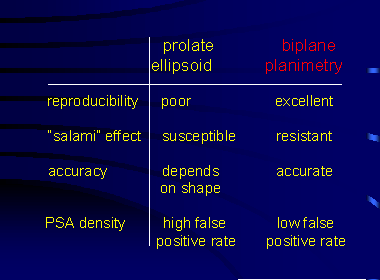
(3)(Next slide please)
We proposed a new calculation method; "biplane planimetry".

(4)(Next slide please)
Based on the cross contour and sagittal contour, the volume of this model is calculated. The model is composed of sequentially arranged copies of the cross section. The copies are reduced to fit the sagittal contour, and so the formula is : slice thickness times Area max times the sum of the height reduction rates.
Hi are the heights measured at a certain interval in the sagittal section, the maximum of which is Hmax.
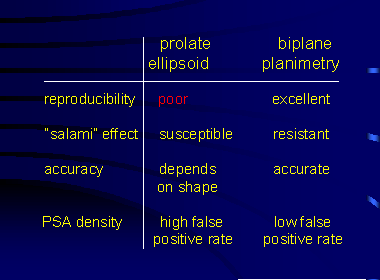
(5)(Next slide please)
Reproducibility is poor in prolate ellipsoid,
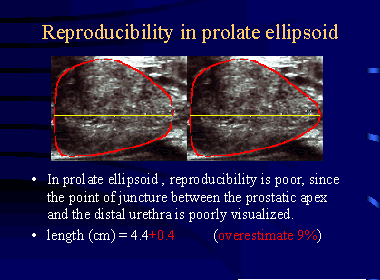
(6)(Next slide please)
since the prostatic apex is often unclear.
Some operator may judge this point as the apex, then length is 4.4cm. Another operator may judge this as the apex, then length is 4.8cm. This yields 9% difference.
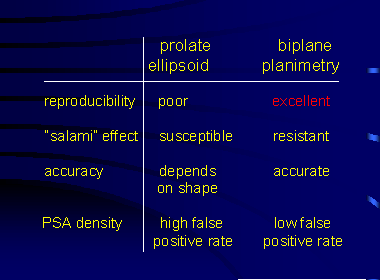
(7)(Next slide please)
Poor visualization of the prostatic apex does not yield a significant error in biplane planimetry.
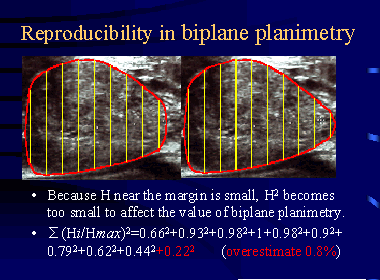
(8)(Next slide please)
Because height near the apex is small, the square of height becomes very small.
If this point is judged as the apex, the sum of the squares of height reduction rate is given by the equation printed in black. Even when this point is judged as the apex, the increase of the sum is only 0.22 times 0.22. This yields only 0.8% difference.
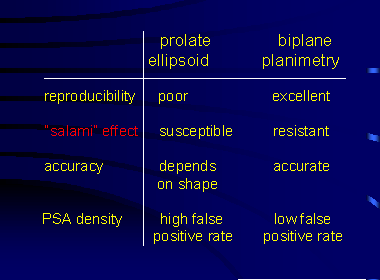
(9)(Next slide please)
The influence of the tilt of the scanner on the volume is called "salami effect".
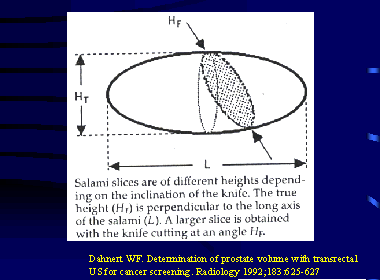
(10)(Next slide please)
Just like salami slices are of different heights depending on the inclination of the knife, the shape of the cross section changes with the scanning angle.

(11)(Next slide please)
Prolate ellipsoid is susceptible to "salami effect".
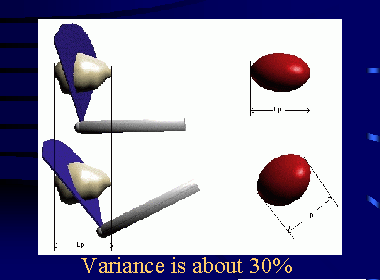
(12)(Next slide please)
As the height changes with the inclination of the scanner, height times width times length times pi/6 is susceptible to "salami effect".
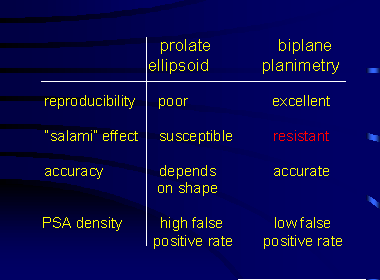
(13)(Next slide please)
Biplane planimetry is resistant to "salami effect".
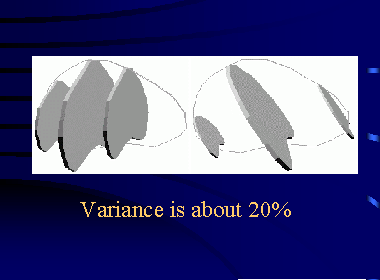
(14)(Next slide please)
Using prostatic 3D models, we demonstrated that the biplane planimetry was more resistant to "salami effect" than prolate ellipsoid.
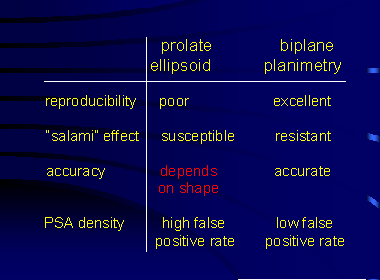
(15)(Next slide please)
Accuracy of prolate ellipsoid depends on the prostatic shape.
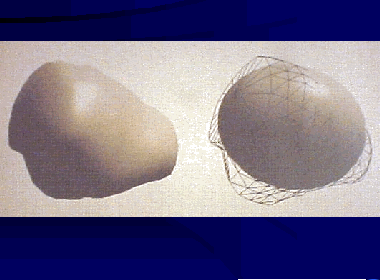
(16)(Next slide please)
The 3D models of BPH and prolate ellipsoid are shown. Prolate ellipsoid has a tendency to underestimate the volume in BPH, because rectal surface of the prostate in BPH is pressed by ultrasonic probe.
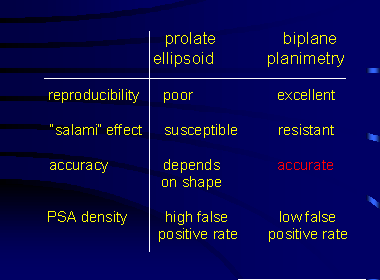
(17)(Next slide please)
Biplane planimetry is accurate, regardless of the prostatic shape.
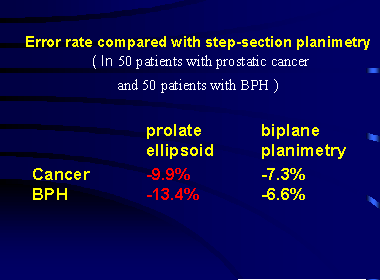
(18)(Next slide please)
The accuracy of the two methods was compared in 50 patients with prostatic cancer and 50 patients with BPH.
Prolate ellipsoid underestimated the volume by 10% in cancer and by 13% in BPH, while the biplane planimetry underestimated the volume by 7% both in cancer and BPH.
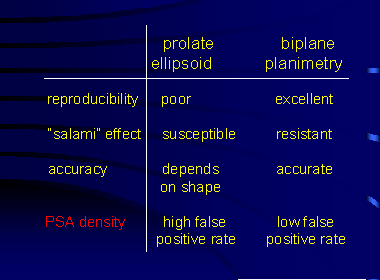
(19)(Next slide please)
PSA density is used to improve the specificity of prostatic specific antigen.
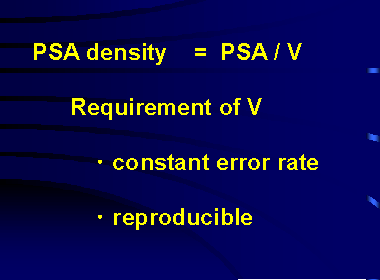
(20)(Next slide please)
PSA density is the quotient of PSA divided by prostatic volume. Requirements of volume measurement are constant error rate regardless of prostatic shape, and reproducibility.
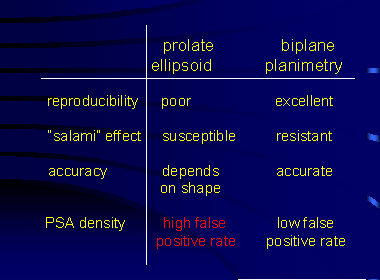
(21)(Next slide please)
Underestimation of volume leads overestimation of PSA density.
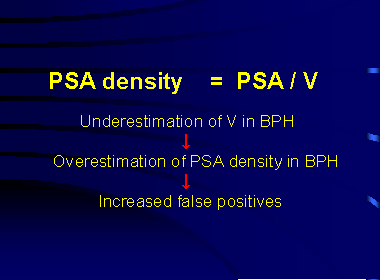
(22)(Next slide please)
Underestimation of volume only in BPH leads overestimation of PSA density in BPH.
Therefore, the prolate ellipsoid has a risk to increase false positives of PSA density.
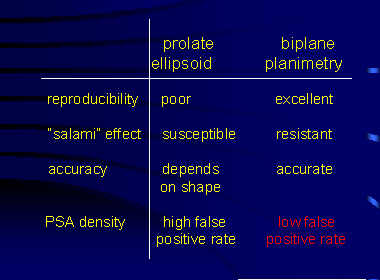
(23)(Next slide please)
Biplane planimetry underestimates the volume of cancer and BPH by the same degree.
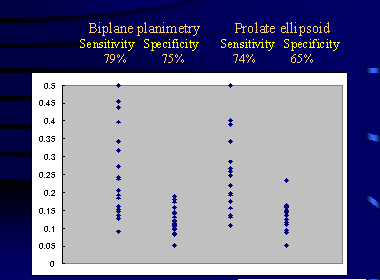
(24)(Next slide please)
Prolate ellipsoid and biplane planimetry were compared as denominators in PSA density.
In nineteen patients with prostatic cancer and twenty patients with BPH having intermediate PSA values, prostatic volumes were calculated both by prolate ellipsoid and biplane planimetry.
Using a cutoff of 0.15, the sensitivity and specificity by biplane planimetry were 79% and 75%, while those by prolate ellipsoid were 74% and 65%.

(25)(Next slide please)
In conclusion, biplane planimetry is reproducible, is resistant to salami effect, is accurate, and has low false positive rate in PSA
density. Thank you.




























